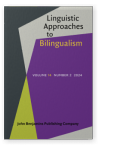Vol. 14:2 (2024) ► pp.178–217
Null and overt pronoun interpretation in L2 Mandarin resultative constructions
This experimental study examines the acquisition of null and overt pronoun interpretations in Chinese as a second language by native speakers of English. A linguistic phenomenon not present in the native language of the learners is identified: the null element in the embedded subject position of Mandarin resultative constructions can only refer to the main-clause subject, while an overt pronoun in the same position can refer both to the main-clause subject and to another entity in the discourse. Thus the acquisition task includes learning a new functional morpheme, a null element, as well as constraining its interpretation in the resultative construction. We tested 59 L2 learners of Chinese at different proficiency levels and 51 native Mandarin speakers on a Truth Value Judgment Task. The learners showed a pattern of interpretation that was statistically indistinguishable from the native speakers’ in all but one context. We argue that our findings point to largely successful acquisition of the requisite proform interpretations, even though the restrictions on the interpretation of null elements cannot be transferred from the native language.
Article outline
- 1.Introduction
- 2.Native interpretation of Mandarin resultatives
- 2.1Previous syntactic analyses
- 2.2 Shibata and Yashima (2014)
- 2.3Experiment 1: L1 Mandarin speakers
- 2.3.1Participants
- 2.3.2Task
- 2.3.3Procedure
- 2.3.4Statistical modelling
- 2.3.5Results
- Descriptive statistics
- Inferential statistics: Mixed effects models
- 2.4Discussion of Experiment 1
- 3.L2 acquisition of Mandarin resultatives
- 3.1Two L2 acquisition accounts
- 3.2Linguistic analyses of English resultative constructions
- 3.4What needs to be acquired?
- 3.5Experiment 2
- 3.5.1Research questions and hypotheses
- Research Question 1
- Hypothesis 1
- Research Question 2
- Hypothesis 2
- 3.5.2Participants and procedures
- 3.5.3Statistical modelling
- 3.5.4Results
- Descriptive statistics
- Inferential statistics: Mixed-effects models (L2 learners)
- Inferential statistics: Mixed-effects models (L2 learner & native speaker comparisons)
- 3.5.1Research questions and hypotheses
- 3.6Discussion of Experiment 2
- 4.General discussion
- 4.1Is the null element interpretation a challenge in L2 acquisition?
- 4.2Full Functional representation and poverty of the stimulus
- 4.3Proficiency effects
- 4.4Coreferential reading preference with the overt pronoun
- 5.Conclusions
- Acknowledgements
- Notes
-
References
